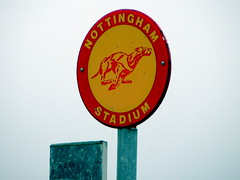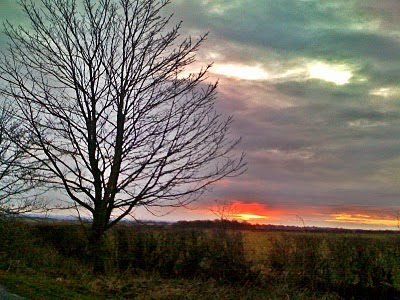However, I do want to share what the final part of my work experience provided me - the opportunity to see behind the scenes at Nottingham Greyhound Stadium.
I'm well aware of how the racing industry polarises opinion and I don’t want to get into the rights or wrongs of racing, this isn’t what my blog is about. As previous posts have explained, I want to work with retired greyhounds, and their owners, post-racing and to do this I feel that I need to understand how these hounds have been nurtured before their retirement life as a sofa surfer.
I can only blog about what I saw - not what may happen at other tracks or at other trainers.
A 'civvy' goes trackside
 |
| Nottingham Stadium. Photo: John Wardell |
I also wanted to use the opportunity to observe greyhounds’ behaviour before and after a race – not something you can easily do as a spectator. At university, we’re encouraged to observe behaviour from a scientific point of view, which can be very hard when you have an emotional attachment to a breed or dog.
Greyhound Board of Great Britain
The Greyhound Board of Great Britain (GBGB) is the governing body for greyhound racing at licensed tracks in the UK. GBGB came about as a result of the 2007 Lord Donoughue report into greyhound racing. The report was commissioned in the wake of reports of greyhound welfare issues, notably at Seaham, Co. Durham, which – quite rightly – created a media storm and alerted the public to some of the welfare problems surrounding the sport during the passage of the Animal Welfare Bill. At the time greyhound racing was overseen by two bodies – The British Racing Greyhound Board and the National Greyhound Racing Club. As a result of this report, GBGB was established in January 2009. However, GBGB is only responsible for governing the racing at GBGB licensed tracks and not the unlicensed 'flapping' tracks.
At the track
For many kennel hands, track days are long days. You’re on the go from early morning until at least 11pm/midnight.The hounds that are racing on that particular day are carefully checked at the kennels - they are weighed, groomed and checked to make sure they’re in full health prior to racing. Then mid-afternoon, the hounds are prepared for their journey to the track and are put in the van, in individual crates/compartments, ready to go the track. Depending on the trainer, most vans are equipped to transport between 6-12 greyhounds.
When we arrived at the track, we unloaded the dogs one by one. Our first task was to let them go for a pee and a poop (there was a sandy area especially for this, fully equipped with bins and shovels). If I timed it right I realised I could position the shovel in the right place – as anyone who’s read my previous post will know that I couldn’t manage the flick of the poop onto the shovel! - and 'catch' the poop before trying to make a mess of scooping it.
Then each dog was taken into the kennel area. This is an air conditioned building, with an outside paddock area, where the hounds are checked and gathered immediately before a race, and rows of internal kennels.
The amount of checks each hound underwent were phenomenal. When you arrive in the kennel area, you provide the dog’s name to a member of the track staff and then the checks begin… Firstly, the dog’s ear tattoo (or tattoos if he/she is a dog of Irish origin) is checked and compared against the name and database information. Then the dog is scanned for his/her microchip – again to check that the dog isn’t a ringer. These details then appear on a TV screen above the scales, where the dog is weighed. A racing greyhound's weight can only fluctuate within 1 kilo of his/her last racing weight - if the hound is over 1 kilo heavier or lighter they will not be allowed to race.
 |
| Racing at Nottingham. Photo: David Yanez on Flickr |
Once the identity of the dog has been checked and verified, it was time to go through to the kennel area - when entering this area, the dogs have to be muzzled. The dogs are then checked by the vet before being admitted to their individual kennel. The vet checks their gait, general health and re-checks the ear tattoos.
Each dog is given a kennel which is numbered and allocated by race. The kennels are the size of a large crate (as in crates used by many pet dog owners) and provide enough space for the hounds to stand up, move around and lie down. Each kennel has clean bedding of the vet bedding variety and is airconditioned/well ventilated.
Before the dog is popped into their kennel, a member of staff checks the ear marks again and scans the microchip. Once the hound is in their kennel, the door is locked. The reason the door is locked is to prevent any tampering with the dog before a race.
Race time
When it's time to prepare the dog for his/her race there are another series of checks to go through. When collecting a dog from their kennel, I had to provide the member of the track staff with the dog's race name, the race he/she was in and their kennel number.The member of staff then unlocks the kennel to let the dog out. The dog's ear marks are re-checked and then I was able to put the dog in their racing jacket, fix their race muzzle and attach their leather fishtail collar and lead. The dog is then led by the handler into the paddock area, where he/she is scanned again for the microchip and another vet check is undertaken.
When given the signal the handler leads the dog out onto the track, where the dog is announced to those attending the race. Upon another signal each dog is taken to the traps and they are placed individually into the relevant trap. They are only in the trap for a matter of seconds before the race begins.
(Video is of my greyhound Stevie & was provided by his racing owner prior to his retirement . This race took place before GBGB was established)
At the end of each race the vet is there to check each hound after he/she has finished the race. If any hound has sustained an injury the vet is able to treat them.
Once the race is finished each dog is taken back to the paddock by the handler and checked over. Their faces are washed to get rid of any sand and their paws are washed and checked to get rid of sand and to make sure there are no cuts. They are then taken back into their individual kennel and provided with a fresh bowl of water. The track is very stringent about leaving each dog in their kennel for a minimum of 15 minutes after the finish of each race (instead of taking them straight back to the trainer's van). Again, this is to ensure that the health is not compromised - if there was an issue that did not present itself immediately after a race, the time lag ensures that if there was such an injury the vet could attend to it.
The track at Nottingham is 437m in circumference and on the occasions I was at the track I witnessed one accident where a pair of hounds bumped each other and one ended up doing a somersault. This is the part of the sport that I, and from the trainers I spoke with, dread. Everyone wants their dog to come home safe and injury-free. In the race where the bump happened, both the dogs seemed to be fine and were checked by the vet. However, another dog which was not involved in the bump had gone lame and was attended to by the vet immediately after the race.
Welfare Observations
At one of the races I attended I was interested to see that there was a Greyhound Welfare Officer listed in the programme and present at the track. I spoke with him as I was intrigued to understand his role. He is responsible for ensuring the welfare of the dogs both at the track and those who are about to retire. If he feels that the welfare of a dog is compromised, my understanding is that he is able to take relevant action to tackle it.
With the number of checks in force at the track I visited it would be very difficult to tamper with any dog or substitute a ringer once they're at the track. GBGB also has a stringent approach to anti-doping. At any GBGB licensed track, random urine sampling and tests can be undertaken to test whether a dog has been doped.
I was especially interested to observe the dogs' behaviour when they were with their handler, waiting in the paddock just before the race started. I was on the look out for stress signals such as hyper vigilance, lip licking, crouched body posture, panting and shaking. Whilst I did see signs of stress in some dogs, I did not see signs in all dogs. And those that were exhibiting stress signals were not the extreme signals of stress that I have sometimes seen at general dog shows and in rescue kennels. In contrast there were some dogs that showed signs of anticipation that we would probably term as excitement (think how excited your dog may get when he/she is shown their lead).
Overall, I was impressed with the facilities and standards of care I saw at the track. I understand that injuries may happen but, in my opinion, injuries can happen as equally off the track as on (just ask my dog Mina).
The future of racing
So what does the future hold for greyhound racing in the UK? Track attendances are dwindling and there are calls to ban the industry.
What would happen though if greyhound racing was banned? There would certainly be an economic impact for those who run racing kennels and those connected to racing – staff at tracks and kennels, manufacturers (pet food, bedding etc), along with the rehoming charities and rescue centres. And what about the dogs themselves? If greyhound racing was banned tomorrow, would it lead to mass euthanasia of the thousands of dogs in racing kennels? How and where would these dogs be homed?
It may surprise you to know that despite the number of greyhounds that retire from racing each year, the Greyhound is listed on the Kennel Club’s native vulnerable breed list. In 2010 only 65 pedigree greyhounds were registered with the Kennel Club and up to the end of September 2011 only 12 greyhounds have been registered.
I don't know what the answer is and I can see both sides of the argument for and against racing. At the end of the day the greyhound is an amazing breed and one that I hope I will always have the privilege of working and sharing my life with.
Please do comment and share your views.*
*Please keep responses polite. Any abusive comments will not be tolerated and will be removed.
PS You can read my previous posts on my work experience here:
It's a dog's life - A look at greyhound racing kennels (Pt I)
It's a dog's life - A 'school' for greyhounds (Pt II)





















